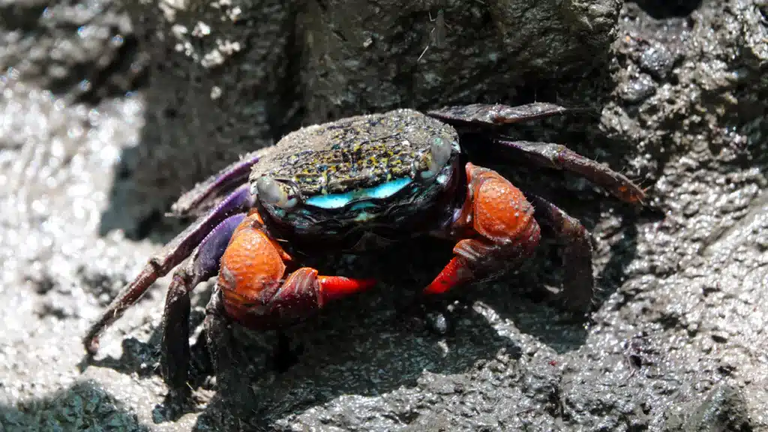This Crab Glows from Its Forehead — And Scientists May Have Finally Figured Out Why
The natural world is filled with astonishing adaptations, and marine ecosystems are no exception. One such curiosity is Parasesarma eumolpe, a species of crab found in the mangrove forests of Southeast Asia. What sets this little crustacean apart? It emits a soft glow from its forehead — a feature that has recently become the focus of scientific investigation.

A Mangrove Mystery: Glowing Crabs
In the tangled roots of Malaysian and Singaporean mangroves, Parasesarma eumolpe crabs sport glowing facial bands between their eyes. These bioluminescent patches act almost like tiny headlamps, casting a gentle light in the otherwise dim environment. It’s an unusual trait among shallow-water species, more commonly seen in deep-sea creatures.
Notably, the glow varies by sex. Male crabs tend to emit a brighter blue light than females, hinting at a role in sexual signaling. Scientists believe this difference may help crabs recognize potential mates in the murky, visually challenging mangrove waters.
The source of the glow has long been traced to the crabs' diet. As scavengers, they feed on decaying leaves and organic matter rich in carotenoids — pigments found in plants and algae. These compounds help produce the light-emitting effect. Starve the crab, and the glow fades — further confirming the dietary link.
Cracking the Code of the Glowing Forehead
While the source of the glow was known, its purpose remained speculative — until now. A recent study published on May 20, 2025, in a leading ecology journal has provided compelling evidence for its function.
Researchers conducted experiments by gently immobilizing crabs in chilled water and monitoring how others reacted to their glowing signals. The findings were striking: crabs were more drawn to individuals whose facial bands glowed in hues similar to their own. This suggests the light acts as a communication tool — a visual language among crabs.
The researchers discovered that the bands' concave structure enhances this signaling, much like a flashlight reflector. By focusing and amplifying the glow at certain angles, the crab’s light becomes more visible to nearby peers, particularly in the dim, dappled light of mangrove forests.
This kind of signaling mirrors communication in other species, though with very different mechanisms. For instance, chimpanzees use facial expressions and gestures, while these crabs use light.

Source
Light as Evolution’s Messenger
Bioluminescence is nothing new in marine biology. Deep-sea creatures like anglerfish and squid have long fascinated scientists with their glowing features. But Parasesarma eumolpe is unique. Unlike its deep-sea cousins, it thrives in sunlit, shallow waters — meaning its glowing adaptations had to evolve under very different conditions.
Its forehead bands appear fine-tuned for visibility in shifting mangrove light, highlighting an evolutionary precision that rivals adaptations seen in predators like great white sharks.
Current research points to a possible role in male competition. The brighter glow in males may help establish dominance or mark territory. These light displays, then, could be crucial in social interactions and mating behavior.
Though not relics of a bygone era, these crabs offer a window into how evolution crafts intricate tools for survival. Their glowing foreheads may be more than just a quirk — they could help us better understand the evolution of light-based communication in the animal kingdom.
As scientists continue to study Parasesarma eumolpe, these humble crabs may help illuminate broader insights into how organisms adapt and thrive through the power of light.
Do you think human technology could mimic this natural form of communication in future designs?
https://www.reddit.com/r/nottheonion/comments/1l8qgl3/this_crab_glows_from_its_forehead_and_scientists/
https://www.reddit.com/r/EcoNewsNetwork/comments/1l8qzax/this_crab_glows_from_its_forehead_and_scientists/
This post has been shared on Reddit by @loading through the HivePosh initiative.